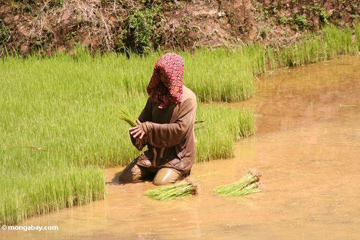Climate risks to global agriculture are underestimated
Climate risks to global agriculture are underestimated
mongabay.com
December 3, 2007
Vulnerability of global agricultural to climate change may be underestimated by experts, warns a trio of papers published in week’s issue of the Proceedings of the National Academy of Sciences (PNAS). The research says that “progressive changes predicted to stem from 1- to 5-degree C temperature rises in coming decades fail to account for seasonal extremes of heat, drought or rain, multiplier effects of spreading diseases or weeds, and other ecological upsets,” according to a statement from Columbia University’s Earth Institute.
“Many people assume that we will never have a problem with food production on a global scale. But there is a strong potential for negative surprises,” said Francesco Tubiello, a physicist and agricultural expert at the NASA/Goddard Institute of Space Studies who coauthored all three papers.
The researchers say that current grain production—from which humans derive two-thirds of their protein—would need to double before 2100 in order to keep pace with demand from population growth, but that agricultural gains in temperate regions would not be enough to offset declining productivity in the tropics, due to higher temperatures and reduced precipitation. By some estimates, developing countries may lose 135 million hectares (334 million acres) of prime farm land in the next 50 years.

|
Tubiello says that current forecasts fail to incorporate the possibility of temperature spikes, extreme weather, and outbreaks of weeds and pests.
“The projections show a smooth curve, but a smooth curve has never happened in human history,” he said. “Things happen suddenly, and then you can’t respond to them.”
The authors say that extreme-weather events can “easily wipe out crops on vast scales” when the occur during critical periods like germination or pollination. For example droughts in the 1980s and 1990s in Africa destroyed 20% to 60% of livestock in some countries.
Higher temperatures may also boost outbreaks of weeds and pests. One of the PNAS papers, “Crop and Pasture Response to Climate Change,” warns that the range of cattle ticks and bluetongue (a viral disease of sheep and cattle) will may expand from the tropics to more temperate areas, while higher temperatures may allow other pathogens to survive cold winters in northerly regions. Higher temperatures may also “limit the ability of modern dairy-cow breeds to convert feed into milk, and lead to declines in livestock fertility and longevity.”

|
The authors say that while the outlook for poor farmers is bleak, adaptation may be their best approach to dealing with climate change. “Adapting Agriculture to Climate Change” argues that measures like “climate-forecasting systems that enable farmers to switch to different crops or change the timing of plantings; introduction of new varieties or species that can withstand anticipated conditions; and improved flood-mitigation and water-storage facilities” may help farmers though temperature rises of 1.5 to 3 degrees in the tropics and 1 to 2 degrees at temperate latitudes.
This article is based on media materials from Columbia University’s Earth Institute.














